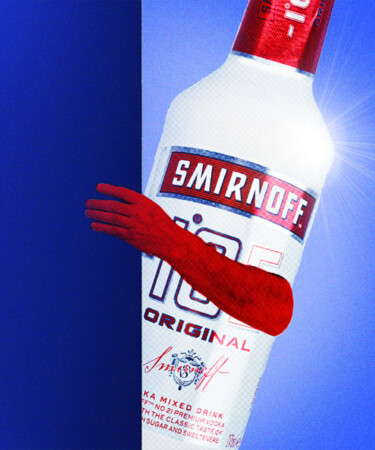If you were partying at college sometime during the Obama Administration, there’s a good chance you’ve gotten “Iced,” or tricked into chugging Smirnoff‘s most famous malt beverage on one knee. And if you’re unfamiliar with the carbonated burn, uncontrollable belching, and potentially bruised kneecap that comes with that fraternity-adjacent tradition, we can assure you that ignorance is bliss. For those of us who have crushed a Smirnoff Ice in front of a sizable crowd, it’s a drinking challenge that’s become ubiquitous with tailgates and basement ragers. What most don’t know, though, is where and when Icing began.
The cooler craze was certainly a factor in the trend’s inception. In 1990, Bacardi introduced the Breezer: a low-ABV bottled beverage with rum, fruit juices, natural flavors, and carbonated water. And thus, the alcopop was born. The ‘90s saw a number of other ready-to-drink, fruit-flavored coolers pop up on the market over the rest of the decade, including Hooch, Zima and, come 1999, Smirnoff Ice.
Smirnoff’s flavored malt beverage enjoyed moderate success in the early aughts, sold with slogans like “As Clear As Your Conscience” and “Intelligent Nightlife.” The real marketing ringer, though, would arrive about a decade after the drink’s launch — and it was utterly beyond parent company Diageo’s control.
Nobody really knows exactly where “Icing” first originated, though some sources point to New England liberal arts college fraternities and sports houses. The gag was simple: Hide a Smirnoff Ice for your friend to find, and once they discover it, they have to get down on one knee and chug it. The only way to counter an Icing is to have an Ice on your person at that moment, in which case you can reverse the prank on the instigator.
Early evidence of “Icing” was shared on Blackberry Messenger and other pre-social media platforms, but the trick took on a life of its own in April 2010. A few brothers from the Pi Kappa Alpha fraternity at the College of Charleston sent an official “Icing” guide to the men’s lifestyle website BroBible.com. An anonymous fellow student was inspired by the prank, and simultaneously launched “Bros Icing Bros,” a Tumblr where he posted submissions of Icing footage. The page blew up, reportedly receiving around 100 photos or videos per day at its peak. As the phenomenon went viral across college campuses nationwide, said bros would employ Wile E. Coyote-style methods in their Icing, one-upping each other with elaborate plots to hide and reveal Smirnoff Ice bottles.
“Bros Icing Bros was the place where these things were really getting collected as the center of the spoke,” BroBibile.com’s publisher Brandon Wenerd told Dave Infante on a recent episode of VinePair’s “Taplines.” And it didn’t take long for the media at large to take notice: “This started to get traction with the arbiters not of niche culture — not of bro culture — but of mainstream centrist American culture,” Infante explains. By mid-June, major outlets like The New York Times and Fortune Magazine had published articles about Icing.
At the time, there was some confusion as to whether Smirnoff’s parent company Diageo was behind the whole thing. It wouldn’t have necessarily been surprising, considering the absurdity of Smirnoff’s “Hard Tea” ad campaign a few years prior. But not only did Diageo have nothing to do with it — they wanted nothing to do with it. The beverage giant released a statement through Ad Age magazine that same month rejecting the practice.
“Diageo has taken measures to stop this misuse of its Smirnoff Ice brand and marks, and to make it clear that ‘icing’ does not comply with our marketing code, and was not created or promoted by Diageo, Smirnoff Ice, or anyone associated with Diageo,” said the statement. In late June, the company made quick work to shut down Bros Icing Bros just three months after its inception.
If there are two things alcohol companies consistently avoid encouraging publicly, they’re overconsumption and underage drinking. And while Icing wasn’t technically promoting either one, it was damn-near close.To boot, the focus on “bros” and frat culture was widely viewed as misogynistic. Backlash ensued after a June 2010 Youtube video entitled “How to Ice a Bro” went viral featuring a college-age man declaring, “It’s bros icing bros — no hoes.” Ironically enough, the brand worried that the beverage was being perceived as a drink intended only for women after its initial release. In 2002, Diageo unleashed Smirnoff Black Ice, a less sweet variant aimed at male drinkers.
After Diageo put the kibosh on Bros Icing Bros, the internet moved on to the next thing, and the dust settled. But the college-age practice continued to thrive, even though the cameras weren’t beckoning. And while Icing may be past its prime, the sensation has still somehow cemented itself in drinking-game culture. Its low-brow legacy is a fascinating example of how the early social internet shaped and scandalized the beverage alcohol business.
These days, Smirnoff Ice is still very much available, and you’ll find it in 18 different flavors — in case nostalgia calls.
